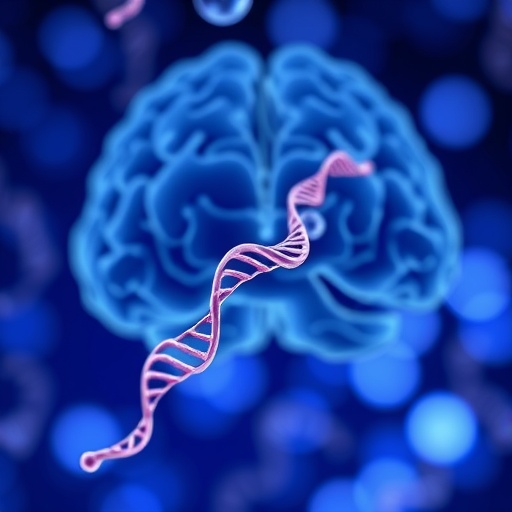In a groundbreaking study poised to revolutionize the early detection of Alzheimer’s disease, researchers have identified a compelling association between salivary mitochondrial DNA (mtDNA) levels and established biomarkers of the neurodegenerative disorder in cognitively normal older adults. This pioneering work offers fresh insight into non-invasive diagnostics and sits at the intersection of molecular biology, neurology, and geriatric medicine, holding the promise of transforming how Alzheimer’s progression is monitored before the onset of clinical symptoms.
Alzheimer’s disease, a devastating condition characterized by progressive cognitive decline and memory loss, has long eluded early, non-invasive diagnostic techniques. Current modalities typically rely on cerebrospinal fluid analyses or neuroimaging, which, despite their accuracy, are invasive, costly, and inaccessible for routine screening. The discovery that mtDNA extracted from saliva correlates with in vivo brain biomarkers marks an unprecedented advance, providing a readily available biological substrate for Alzheimer’s risk assessment.
Mitochondria, often dubbed the cellular “powerhouses,” possess their own DNA distinct from nuclear DNA. This mitochondrial genome is highly susceptible to damage from oxidative stress and aging, both critical contributors to neurodegeneration. The study elegantly links alterations in salivary mitochondrial DNA—a proxy for mitochondrial health and cellular stress—to the early pathophysiological changes occurring in the brains of individuals who otherwise show no cognitive impairment.
This multi-faceted investigation harnessed cutting-edge techniques in molecular quantification and neuroimaging to probe the relationship between salivary mtDNA concentrations and amyloid-beta and tau protein depositions, hallmark neuropathological features of Alzheimer’s disease. Utilizing positron emission tomography (PET) imaging alongside cerebrospinal fluid assays, the researchers meticulously characterized the brain biomarker profile in older adults, paralleling these with precise measurements of salivary mtDNA.
Intriguingly, the researchers observed a robust positive correlation between elevated salivary mtDNA levels and increased amyloid and tau pathology. This finding suggests that mitochondrial dysfunction, as reflected by the heightened release or diminished clearance of mtDNA in saliva, may serve as an early peripheral signal of cerebral neurodegenerative processes. Such peripheral indicators are invaluable because they circumvent the need for invasive procedures, opening the door for widespread screening and longitudinal tracking.
The implications of this research extend beyond diagnostics. Mitochondrial dysfunction is widely recognized as a central player in Alzheimer’s pathogenesis, implicated in disrupted energy metabolism, oxidative damage, and neuronal death. The ability to quantify mitochondrial DNA alterations non-invasively in saliva hints at novel therapeutic monitoring tools, allowing clinicians to gauge mitochondrial-targeted interventions or lifestyle modifications aimed at preserving neuronal vitality.
Moreover, the accessibility of saliva sampling, combined with the high correlation to established Alzheimer’s biomarkers, posits it as a candidate for integration into routine geriatric health assessments. The practical advantages—non-invasiveness, ease of collection, and cost-effectiveness—could democratize early detection, particularly in community and primary care settings lacking specialized neuroimaging infrastructure.
The research also delves into the mechanistic underpinnings of why salivary mitochondrial DNA levels change in relation to central nervous system pathology. While the precise physiological pathways remain to be elucidated, the study postulates that systemic alterations in mitochondrial function manifest peripherally through increased mtDNA release into bodily fluids, possibly via extracellular vesicles or cell-free DNA mechanisms linked to apoptotic and inflammatory processes. These hypotheses open fertile ground for future exploration.
An additional noteworthy aspect is the study’s focus on cognitively unimpaired elderly individuals, a population representing the critical window for intervention before symptomatic decline. Detecting Alzheimer’s-associated changes at this preclinical stage offers unprecedented opportunities for preventive strategies, shifting the narrative from treatment to early risk stratification and potential disease modification.
From a methodological perspective, the research employed rigorous analytical assays including quantitative PCR techniques optimized for salivary DNA extraction and amplification. These assays were validated with rigorous controls to ensure specificity and reliability. Paired with high-resolution PET imaging, this combination underscores the scientific robustness and translational potential of the findings.
The study, published recently in Translational Psychiatry, represents a significant convergence of molecular diagnostics and neuroimaging, heralding a new era of biomarker discovery that transcends traditional cerebrospinal fluid or blood-based approaches. The authors include leading experts in neuroscience and gerontology, who emphasize the need for large-scale longitudinal studies to confirm and expand upon these promising initial results.
Critically, the researchers caution that while the findings are compelling, salivary mtDNA measurement is not yet a standalone diagnostic tool. Rather, it should be integrated into a comprehensive clinical framework alongside cognitive assessments, genetic risk profiling, and imaging to formulate personalized risk assessments and therapeutic strategies.
In conclusion, the identification of salivary mitochondrial DNA as a correlate of Alzheimer’s disease biomarkers in cognitively normal older adults offers a paradigm shift in how neurodegeneration could be detected and monitored. This research bridges the gap between peripheral biofluids and central nervous system pathology, underscoring the potential for minimally invasive, cost-effective screening tools in the battle against one of the most challenging diseases of aging.
As the scientific community continues to unravel the intricate relationship between mitochondrial health and neurodegeneration, these findings highlight the critical importance of cross-disciplinary approaches combining molecular biology, neuroimaging, and clinical neuroscience. Future advances spurred by this work may pave the way for routine screening programs that identify at-risk individuals long before clinical symptoms emerge, potentially altering the trajectory of Alzheimer’s disease through early intervention.
Indeed, the translational potential of salivary mtDNA assessment is immense, not only for Alzheimer’s but possibly for a spectrum of neurodegenerative disorders where mitochondrial dysfunction plays a key role. As technology advances and analytical methods become more refined, saliva-based molecular diagnostics may soon transform clinical practice, offering hope in the fight against an increasingly prevalent global health challenge.
Subject of Research: Alzheimer’s disease biomarkers and mitochondrial DNA in saliva for early detection
Article Title: Salivary mitochondrial DNA is associated with biomarkers of Alzheimer’s disease in cognitively normal older adults
Article References:
Cantero, J.L., Atienza, M., Podlesniy, P. et al. Salivary mitochondrial DNA is associated with biomarkers of Alzheimer’s disease in cognitively normal older adults. Transl Psychiatry 15, 355 (2025). https://doi.org/10.1038/s41398-025-03589-9
Image Credits: AI Generated




